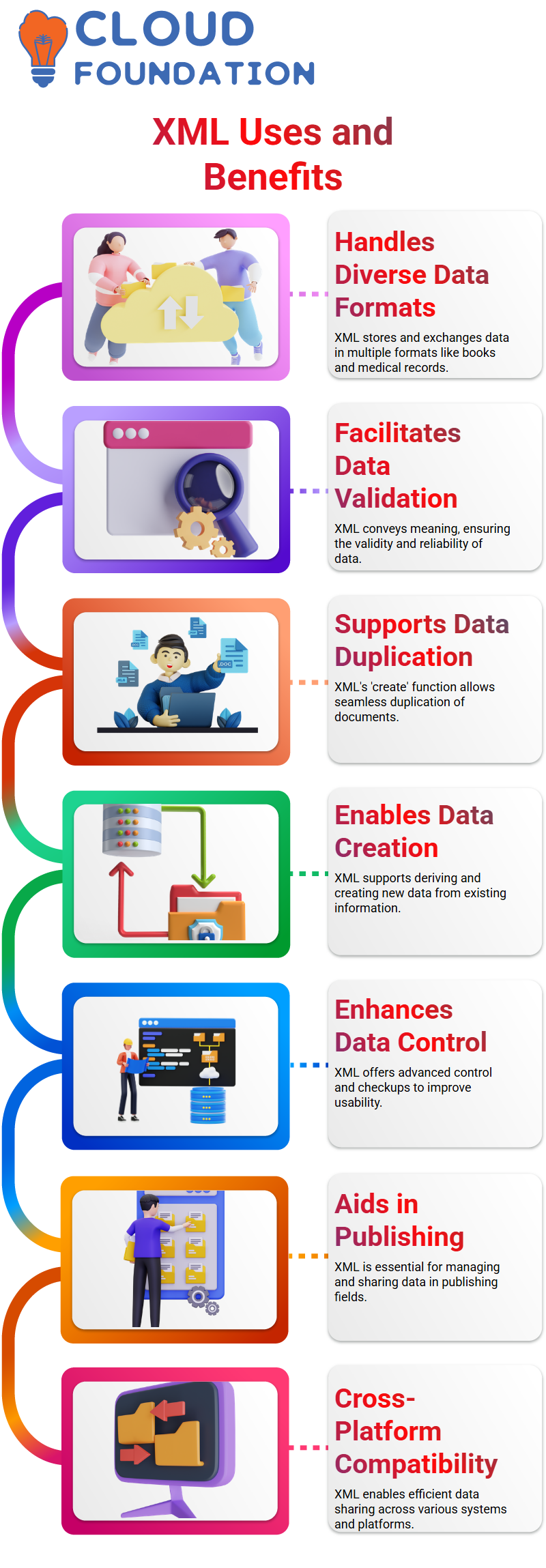What is XML?
What is XML?
XML (Extensible Markup Language) can serve as a foundation for a base language, enabling the creation of various specialised languages.
It is designed to store, carry, and exchange data, which is essential for storing data in various formats. By understanding the principles behind XML, one can create their languages and explore the possibilities of using XML in multiple fields.
XML was not designed to display data but rather to make it available to interested parties. However, it may be necessary for XML to store and make that data available to those who are interested in it.
Use of XML
XML is used to handle data, exchange it widely, and store data in various formats. This data can be stored in multiple formats, including books, medical records, and other types of information.
XML allows for more control and checkups on the information you have, making it more useful. However, XML can also convey meaning, which will enable it to verify the validity of the data.

In addition to storing data in XML, you can use XML to derive and create from the data. This is achieved by using the “create” function. This function enables you to create a new document with the same name as the original, allowing you to create a duplicate document.
XML is a powerful tool for managing and sharing data across various platforms. It allows for more control and checkups, making it an essential tool for publishing and other related fields.
Advantages of using XML
The advantages of XML, a structured data format used in various applications, highlight the importance of XML in communication and the ability to create undefined tags, which adds descriptiveness and makes it easier to visualise what data is received.
XML is platform-independent, making it easier to upgrade to new hardware or software without losing any data.
It also supports Unicode, a numeric representation standard for each character included in the storage file, adding an extra bit of agility to the process.
Data stored and transported in XML can be modified at any point in time, even if incorrect data has been transmitted. XML allows for updates at any point in time, even if false data has been transported.
XML is entirely compatible with Java and 100 Portable, as well as languages such as PHP and Dot.net. It simplifies data sharing between various systems and allows validation using DTD and schema.
The concept of HTML
The concept of HTML is essential in creating web pages and managing content; it involves using the HTML class to create a document that lists all the books in a library.
This document can be ordered or unordered, and it is essential to control the CSS file’s layout to maintain the desired appearance.
When creating an HTML document, it is crucial to separate the content from the presentation, as this can prevent the loss of formatting, background, and other elements.

This can lead to issues with the layout and data. To address this, it is essential to separate the data from the XML format. This separation allows for better information storage and organisation.
To handle the data, separate documents are used to separate the HTML document from the data. The document.html document will contain only the document, including its format, layout, and data. The layout and data are also essential aspects of the HTML document.
HTML is crucial in creating web pages and managing content. It involves using CSS styles to control the layout and data, as well as separating the data to maintain the desired design and organisation.
Differences between XML and HTML
The primary differences between HTML and XML lie in their respective purposes. HTML is designed to store, carry, and exchange data. At the same time, XML is used for manipulating text attributes, such as font, size, colour, and layout.
XML was not designed to display data but rather to make it available to interested parties. However, it may be necessary for XML to store and make that data available to those who are interested in it. This is a crucial difference between XML and HTML, as they serve different purposes and have distinct features.
The primary difference between XML and HTML is that XML is a more advanced markup language with additional features compared to HTML. It is not as simple as HTML, but it is more advanced and has more features than XML. Additionally, XML is used at XML canvas, which separates data from HTML.
XML is a powerful tool for storing, carrying, and exchanging data. It is not designed to display data but rather to make it available to interested parties. However, there are significant differences between XML and HTML, including their distinct purposes, features, and usage. Understanding these differences is essential for both developers and users to utilise both tools and achieve their desired outcomes effectively.
XML Hierarchy
When creating an XML hierarchy, it is essential to ensure that the document is easy to navigate and load in a browser without errors.
This involves asking questions about the document’s structure, format, and structure. If the structure is sufficient, it can be used to list the relative elements and make necessary adjustments.
To enhance the document’s functionality, it is crucial to examine its structure in greater detail and ensure that it can be loaded in a browser. If the document is not simple to edit, it can be improved by using editors to make it easier to navigate and update.

Hierarchies are hierarchical structures that help organise information and relationships between different entities.
They can be created using various tools and techniques, such as hierarchical tables, diagrams, and other visual aids. By carefully considering the structure, structure, and functionality of the document, users can create a more effective and user-friendly document.
Document type declaration (DTD)
The document type definition is an older version of XML, which has its own set of limitations. One of the main limitations is that XML is verbose and redundant compared to JSON, which is a more modern language used for more straightforward applications.
However, XML is still used for the intercommunication of complex applications, making its market presence unavoidable in current applications.
Another limitation is that XML has high storage and transportation costs for large volumes of data. When sending information in XML, additional XML formats are required, which consume more memory and storage.
Additionally, XML does not support arrays; it only supports data in string format, and file sizes are usually huge due to its verbose nature.
To overcome these limitations, XML can be created in real-time using VS Code. In VS Code, users can use multiple extensions to display data formatting and how it is being gathered. To access these extensions, users can use the extension shortcuts in the VS Code interface.
Conclusion
XML (Extensible Markup Language) is a versatile and powerful tool designed primarily for storing, carrying, and exchanging data.
While it is not meant for displaying data like HTML, it allows users to structure and make data available to various parties in a standardised format.

XML’s advantages include platform independence, support for Unicode, and the ability to validate data using DTD or schema, making it an essential tool for ensuring data integrity across different systems.
Although XML is more advanced than HTML, its complexity enables greater control and flexibility, particularly in managing large volumes of data.
Despite these drawbacks, XML remains invaluable in various fields, particularly for applications that require structured and easily transportable data.

Navya Chandrika
Author



